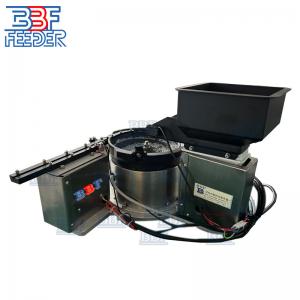
Add to Cart
Magnetic Vibratory Bowl Feeder O-rings Metal Parts Hopper Vibrating Bowl Feeder
1 . Descriptions:
Vibratory feeder bowls have undergone significant advancements since the 1950s. Present-day feeders are self-contained systems that consist of a customized bowl design, a vibrating drive unit with variable amplitude controls, and either a linear feed track or a gravity conveyor for delivering parts individually.
At BBF Feeders, we embrace a modern approach to feeder bowls and incorporate the latest technology into every system we design. Our feeders are user-friendly, easy to operate, and maintain. They include all the necessary components for seamless integration into manufacturing environments, including PLC controls integration.
A vibratory bowl feeder serves the purpose of transferring ingredients from a bulk storage container to a smaller container. These feeders find applications in various industries such as food and beverage processing, pharmaceutical production, fertilizer production, and more.
Vibratory bowl feeders are often used in combination with other production equipment and work best when integrated into a process line with automated filling or packaging machines.
Depending on the type of feeder utilized, it is possible to feed multiple containers simultaneously.
In the case of a vibratory feeder, the containers are positioned beneath the feeder, which then vibrates at a high frequency. This vibration causes the ingredients to fall into the containers, and the vibration is switched off once the predetermined number of items has been dispensed into each container.
2 . Specifications:
| Product name | Vibratory Bowl Feeder |
| Material | Aluminum(AL7075), Stainless Steel(SUS304) or Based on Customers' Requirements |
| Controller | CUH,Sanki,Sinfonia,REO,Afag |
| Voltage | 220V 50HZ/110V 60Hz or Based on Customers' Requirements |
| Power | 300W/500W/1000W/1500W/2000W |
| Material Speciality | Excellent Processing Properties,High Strength, High Hardness |
| MOQ | 1 Set |
| Warranty | 2 Years |
| Certification | CE, ISO9001, ROHS |
| Lead Time | 3 Working Weeks |
3 . Purchasing Process:
To customize and expand a vibratory bowl feeder in your production line, you can follow these steps:
Assess your requirements: Determine the specific customization or expansion needs for your production line. Consider factors such as increased capacity, handling different types of ingredients, or accommodating unique product shapes and sizes.
Consult with a manufacturer or supplier: Seek out a reputable manufacturer or supplier of vibratory bowl feeders. Discuss your requirements and objectives with them to explore available customization options and understand the feasibility of expanding your existing feeder.
Technical evaluation: Provide the manufacturer with detailed information about your current vibratory bowl feeder and the desired modifications or expansion plans. They will assess the technical aspects of your production line and provide recommendations on achieving your customization goals.
Design and engineering: Once the technical assessment is complete, the manufacturer will work on designing the customized components or modifications required for your vibratory bowl feeder. This may involve redesigning the bowl, adjusting the feeding mechanism, or incorporating additional features to meet your specific needs.
Manufacturing and installation: After finalizing the design, the manufacturer will manufacture the customized components and integrate them into your existing vibratory bowl feeder. They will ensure proper installation and alignment to maintain the functionality and performance of the feeder.
Testing and validation: Conduct thorough testing and validation to ensure that the customized or expanded vibratory bowl feeder meets your requirements. Verify its performance, accuracy, and reliability in handling the desired ingredients or products.
Training and maintenance: Train your operators on the modified or expanded vibratory bowl feeder to ensure smooth operation. Establish a maintenance schedule to keep the feeder in optimal condition and address any issues promptly.
Keep in mind that the customization and expansion process may vary depending on your specific requirements and the capabilities of the manufacturer. Close collaboration with the manufacturer throughout the process is essential for successful customization and integration into your production line.
4 . More Pictures:

